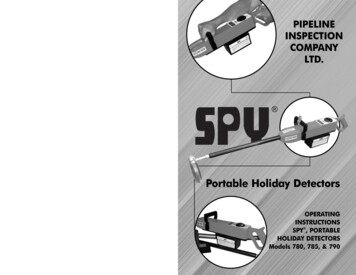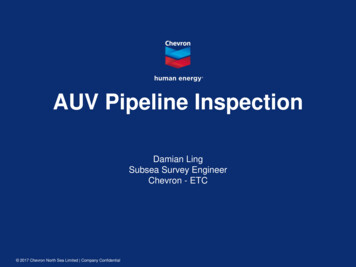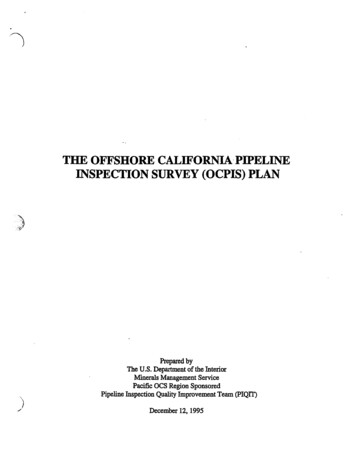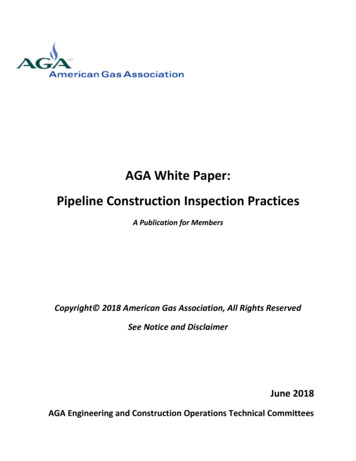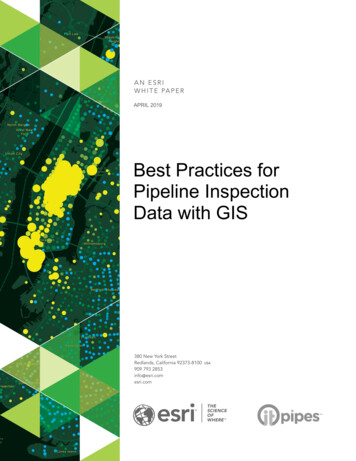
Transcription
APRIL 2019Best Practices forPipeline InspectionData with GIS
Copyright 2019 EsriAll rights reserved.Printed in the United States of America.The information contained in this document is the exclusive property of Esri. This work is protected under United States copyright law andother international copyright treaties and conventions. No part of this work may be reproduced or transmitted in any form or by any means,electronic or mechanical, including photocopying and recording, or by any information storage or retrieval system, except as expresslypermitted in writing by Esri. All requests should be sent to Attention: Contracts and Legal Services Manager, Esri, 380 New York Street,Redlands, CA 92373-8100 USA.The information contained in this document is subject to change without notice.Esri, the Esri globe logo, The Science of Where, ArcGIS, esri.com, and @esri.com are trademarks, service marks, or registered marks of Esriin the United States, the European Community, or certain other jurisdictions. Other companies and products or services mentioned herein maybe trademarks, service marks, or registered marks of their respective mark owners.
Best Practices for Pipeline Inspection Data with GISTable of ContentsExecutive Summary .4GIS and Pipelines .4Benefits of Using ITpipes .5Management of GIS Data .7Why You Should Consider Using a Separate Database .9Conclusion .10AN ESRI WHITEPAPER3
Best Practices for Pipeline Inspection Data with GISBest Practices for PipelineInspection Data with GISExecutiveSummaryUtilities that have adopted a geographic information system (GIS)to support the management and inspection of pipes havesignificantly increased efficiency. Many utilities store pipelineinspection data and GIS data in the same geodatabase.Unfortunately, further down the road, the geodatabase and multipleassociated files become more complex and increasingly vulnerableto serious management complications. An alternative solution thathas long-term sustainability involves keeping the majority ofpipeline inspection data in a separate database. The question,then, is how the pipeline inspection data can be used in conjunctionwith the GIS data. The answer is to use innovative, next generationpipeline inspection software. Such software can link or launch thedata from the two databases with ease, allowing engineers, fieldstaff, planners, and schedulers to have a real-time picture of thestate of the pipeline system. This is a critical step to scaleoperations in the future, especially as various technologies—witheven more data associated—become more commonly used inpipeline inspection.GIS and PipelinesPipes are crucial infrastructure in cities. Pipes deliver commodities like water,natural gas, and petroleum and remove refuse like wastewater, all of which isimportant in daily life. Since the pipes are underground, proper methods must beused to monitor, inspect, and maintain them. GIS has become crucial forgovernments and companies to support pipeline management. Ways in whichthe industry has integrated pipeline management and GIS include the following:Pipeline monitoringOnce a pipeline has been put into place, continual monitoring is necessary toensure that no structural or operational problems, leaks, or geohazards couldarise. This is critical not only for the petroleum industry but also in themanagement of municipal services such as water distribution andwastewater collection. Proper inspection of pipelines—using remotehardware for closed-circuit television (CCTV), sonar, laser, acoustic, ElectroMARCH 20194
Best Practices for Pipeline Inspection Data with GISScan, 1 IBAK PANORAMO, 2 and other inspection technologies—can enableengineers to monitor hazards and determine operational, maintenance, orstructural needs.Emergency responseGIS data has an invaluable role in identifying and mitigating emergenciesthat can occur in pipelines. This is crucial, especially in pipelines thatmanage wastewater and water distribution. The majority of US cities cannotfunction without water distribution and will quickly have major health andsafety issues if water or wastewater collection systems are not functioning.Continuously monitoring for structural and maintenance problems is aproactive approach and enables fast response to any problems with thepipeline before the situation becomes worse. Swift response to pipelineemergencies can protect people and crucial resources.Streamlining field operationsField operations are among the more expensive aspects of pipelinemanagement. However, geographic information systems and inspection datacan be used to significantly reduce these costs. One example is the use ofGIS to locate pipes with maintenance or structural needs for rehabilitationand repair; GIS can be used to identify critical assets and ensure that theyare a higher priority when repairs and/or rehabilitation is needed.Construction project savingsInspection data—when it is easily accessible through GIS and includescomprehensive detail—can be used for planning and prioritizing projectsoutside pipeline maintenance such as street paving, sidewalk repair, andfiber installation. Failing to review the condition of a pipe prior to an assetbeing installed above it can be costly. Imagine having to tear up your newlyinstalled highway because of a failing pipe that needs to be dug up andreplaced. By checking the status of pipelines prior to construction projects,repairs and rehabilitation can be performed prior to an asset installation,potentially saving millions of dollars.Benefits of UsingITpipesITpipes understands the benefits of integration with ArcGIS and provideseffective software that supports pipeline management. Having collaborated withEsri for many years, ITpipes has created intelligent software that bringsinnovative features for pipeline inspection management to your fingertips. Thespecific features and benefits of ITpipes include the following: ITpipes software is integrated with Esri ArcGIS Online, Esri published featureservices, ArcGIS Desktop, and other GIS-based services. This integrationallows engineers and inspectors to create configured go-to solutions usingmaps with pipeline inspection information.12Electro Scan is a registered trademark of Electro Scan Inc.IBAK PANORAMO is a registered trademark of IBAKAN ESRI WHITEPAPER5
Best Practices for Pipeline Inspection Data with GIS The ITpipes software allows the collected data to be transmitted to the fieldworkforce. Fieldworkers are able to use GPS and location awareness to getaccess to existing-condition assessment information, with comprehensivedetail that can help them with their routine inspections. This includes makingstreaming video, graphs, and charts instantly accessible on any device. The ITpipes intuitive workspace helps scheduling by integrating activity toolswith a web map that can be used to provide crew assignments, simplifyrouting, and organize routine and emergency inspections. This is all done inthe software, making it easier for all field crews and supervisory staff toorganize scheduling, planning, prioritizing, and thus monitoring activities. ITpipes has advanced data management that enables reviewers to group,sort, display, and filter report data. As the user adjusts the data view, themap view is dynamically updated as well. This can be based on scheduling;planning operations, maintenance, and structural repairs; or performing otherpredefined reporting. Easy-to-use tools can display coordinated map reportsfrom inspection filters to provide real-time visual analysis of the datacollected. All this can be achieved with the simple setup of ITpipes with Esri'sArcGIS. An easily accessible inspection view includes detailed information and allowsusers to compare old and current inspections for the same pipe. This viewcan be launched, with a single click, from any ArcGIS web map or enterpriseapplication such as Cartegraph, Cityworks, or Lucity products; TylerTechnology's Munis; Novotx; and Maximo. ITpipes software provides GIS administrators with comparison anddiscrepancy reporting tools that are invaluable. These tools can notifyadministrators when discrepancies exist between the GIS attribute data andfield survey information. The tools can be used with a few clicks to applyupdated information to the geodatabase. This keeps maps up-to-date withinformation collected in the field and minimizes GIS administrative efforts. ITpipes is configurable and includes several specific national and regionalstandards. These include SPICAP, PACP, LACP, MACP, SCREAM, andWRC. ITpipes administration tools for IT staff are invaluable. ITpipes provides toolsthat can be used to easily manage data from the multiple inspections of apipeline. Data from the different inspection methods can be integrated toprovide a multidimensional assessment that includes CCTV, laser, sonar,multisensor, inclination, and grout data. This provides a more realistic pictureof sewer mainlines, storm drains, manholes, culverts, laterals, wells, dams,levees, and more.Ultimately, all these features work effectively in providing inspection intelligencewith collaborative mapping. This intelligence enables inspectors and engineers toschedule, plan, collect, and analyze pipe inspections, thereby ensuring that thesystem is fully functional without compromising residents’ way of life.MARCH 20196
Best Practices for Pipeline Inspection Data with GISManagement ofGIS DataGIS data storage practices depend on the size of the organization. For instance,smaller organizations tend to have limited staff that use local GIS files andArcGIS Online, in combination with desktop GIS, COTS product-based browserapps, and native device apps to distribute spatial data.Larger organizations have more complex GIS support, with staff in differentinterdependent branch offices that are responsible for collecting, monitoring, andinspecting segments of the pipeline. For these organizations, a simple, local,software-as-a-service (SAAS) solution does not provide adequate benefits. It ishard to minimize redundancy while ensuring that the right kind of data isaccessible to the right individuals. There are numerous considerations that needto be kept in mind. These include ensuring that: The most recent GIS data is accessible to the stakeholders. The multipledata updates collected in different departments need to be coalesced andpresented as a single data view for the entire pipeline system or an individualpipe. There is an acceptable level of performance of the system in terms ofreliability, speed, and accessibility. The pipeline attribute data is valuable to users by keeping this informationup-to-date. All inspection data—including current and historical inspection informationand various inspection types of data such as CCTV, sonar, and laser—isavailable to users, and that all users have the ability to easily review andcompare inspections. The system facilitates interdepartmental sharing of data. GIS staff should beable to coordinate efforts with field staff to aid in achieving more accurateand efficient pipeline monitoring. There are seamless system updates and upgrades with minimal impact onend-user effectiveness of use. There should be no downtime—in case ofemergency, this information needs to be readily accessible.In larger organizations, GIS data is generally stored in Enterprise Geodatabases(EGDBs) that run on top of a common relational database management system(RDBMS) such as SQL Server, Oracle, and PostgreSQL. Storing data in anEGDB running on an RDBMS provides an enhanced level of data integrity andsecurity because of the inherent advantages of a RDBMS, and it allows data tobe easily accessed from desktop, browser, and native device applications in theoffice or the field. For desktop GIS, this access is via direct databaseconnections, but for browser and native device applications, these datasets areaccessed through RESTful web services provided through ArcGIS Enterprise. Byusing EGDBs coupled with ArcGIS Enterprise, organizations can access, share,and use this geographic content from any device, anywhere, anytime.There is a misconception that all data collected from inspections should beseamlessly added to the same database—this is not very effective for a couple ofreasons. First, the integration of an asset's data—based on multiple inspectionsAN ESRI WHITEPAPER7
Best Practices for Pipeline Inspection Data with GISand hundreds of observations per inspection, as well as hundreds of associatedfiles—pushes the envelope for easy administration. Second, pipeline inspectioninformation changes constantly, and there are associated files that need to bestored. This can easily cause challenges with the management of inspectionsand make it difficult to access the right inspection information through GIS, whenthe data is stored directly inside the geodatabase. We propose that it is better forminimal overall pipeline asset data to be updated in the geodatabase quickly andregularly, and that the majority of the pipeline inspection data be stored in adifferent database. This data must be easily accessible and consumable by GISusers.Typically, there are three levels of data pertaining to pipeline inspection: The first level is the asset detail header that is similar to attribute data thatexists only once per asset. The asset detail header can be used to storeinformation such as the pipe asset identifier; pipe size, shape, material,length, and status; and the date the pipe was built. The second is the inspection header detail that exists multiple times for aspecific asset in the pipeline. These details are recorded for every inspectionperformed. Examples include the inspection date, the reason for inspection,the inspector's name, and the flow. The information may be recordedseveral times during inspection. The third and final level includes observation details that are recordedmultiple times during each individual inspection. This includes the loggeddefects and the severity of the defects. Inspections should always monitorand record the extent of the damage of a specific asset as well as anyupcoming structural or maintenance needs, along with the severity of theoverall need.These three levels of data are continually updated. In addition to these detailsobtained with every inspection and observation, you have associated files. Thesefiles include PDF reports (potentially multiple PDF files for each inspection),snapshot image files of defects (sometimes with several snapshots per defect),video files associated with inspections, laser and sonar imagery, inclination andgrout data, and Acoustic and Electro Scan data and graphs—the list continues togrow.MARCH 20198
Best Practices for Pipeline Inspection Data with GISWhy You ShouldConsider Using aSeparate DatabaseThe most common approach initially requested by agencies is to connect theenterprise geodatabase to thousands of associated files (such as videos) that arereferenced after pipeline inspections are complete. The problem with thisapproach is that it becomes quite difficult to manage these files in the long term.There are always issues with missing files, directory movements, and locationchanges influenced by the new data that is obtained from the pipeline inspection.The most effective solution is connecting your enterprise GIS to a pipelineinspection app that fully manages all of the related reference files, while theinspection data is kept in a different database but is linked with the software. Theapplication will provide the necessary tools required for management andarchiving without burdening the geodatabase with the pipeline inspection data.Using separate databases for inspection and GIS data allows the inspectionsoftware to use a single callout from your Esri application.The following are some of the data sharing options that you can implement: Using the pipeline inspection app allows you to group pipes by asset,inspection, or observation details and visualize this information on a map.With subgrouping on any data field—such as overall or observation piperanking, automated color coding for unlimited grouping, and linear plot toolsto visualize actual defects via color coding on the map—you have allassociated details for planning and prioritizing operations and maintenanceor structural repairs. Plus these tools are easy for any operator, supervisor,or engineer to use and do not require setup by a GIS professional. Setting up an app to launch from your enterprise GIS for creating fullcondition assessment and sharing inspection details is recommended. Youcan easily send a hyperlink to access comprehensive inspection detail viasuch an app. From enterprise GIS, you could send attribute details orhyperlinks. Deploying bid packages for contractors, engineering packages, and more,via an app like this is by far simpler than pushing info out of a geodatabaseand trying to reconnect associated files and pieces for sharing.Using a native pipeline inspection app provides the best practice for analyzing,reporting, reviewing, and sharing inspection information. Storing pipelineinspection information separately from the geodatabase will ensure that data canbe easily managed while producing results that are more successful in the longrun.AN ESRI WHITEPAPER9
Best Practices for Pipeline Inspection Data with GISConclusionGIS has become a crucial part of pipeline monitoring and maintenance. Theadvancement in pipeline inspection techniques and the addition of newmultisensor technology have increased the detail and complexity of the data thatis collected. Typically, most companies want to put all the pipeline inspectiondata with the GIS data into one geodatabase. Unfortunately, this can lead tocomplications and mismanagement in the long term due to the multiple tiers ofinspection data and associated files related to inspections. Pipeline inspectiondata requires different methods for storing and curating it. ITpipes suggests thatinstead of using the rudimentary approach highlighted, companies create aseparate database for storing all the data on pipeline inspections. The softwarewill be able to link the data from the two systems, update enterprise GISattributes of the desired data, and provide management tools for associatedinspection files and imagery. Keeping the databases separate, yet integratingspecific overall pipe inspection attributes, ensures that the data stored in theEGDB does not get complicated or convoluted with the minutiae of pipeinspections. This helps reduce management efforts further down the road, keepsyour data up-to-date, and provides easily accessible real-time analysis to allusers.MARCH 201910
For more information, visitItpipes.com.
pipeline inspection data in a separate database. The question, then, is how the pipeline inspection data can be used in conjunction with the GIS data. The answer is to use innovative, next generation pipeline inspection software. Such software can link or launch the data from the two databases with ease, allowing engineers, field

